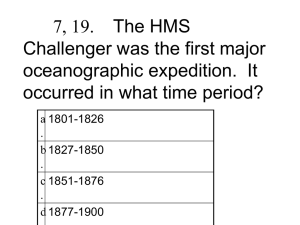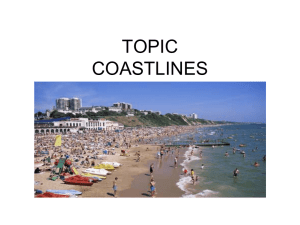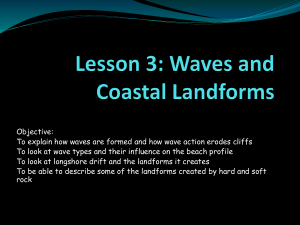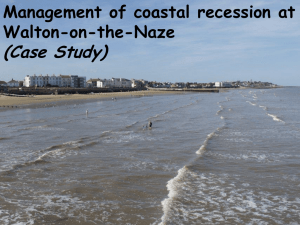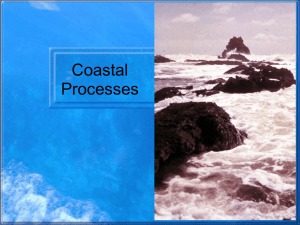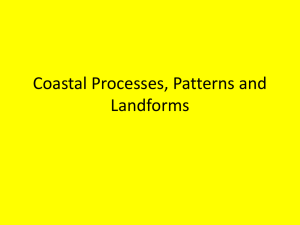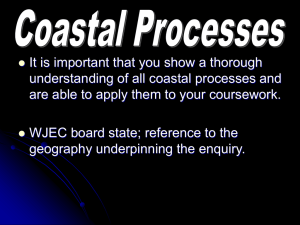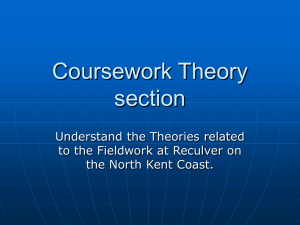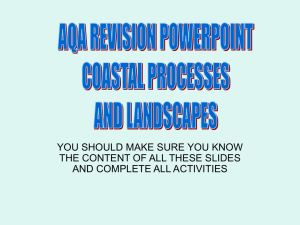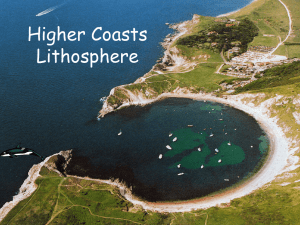Year 8 Coasts Revision PowerPoint 2014
advertisement
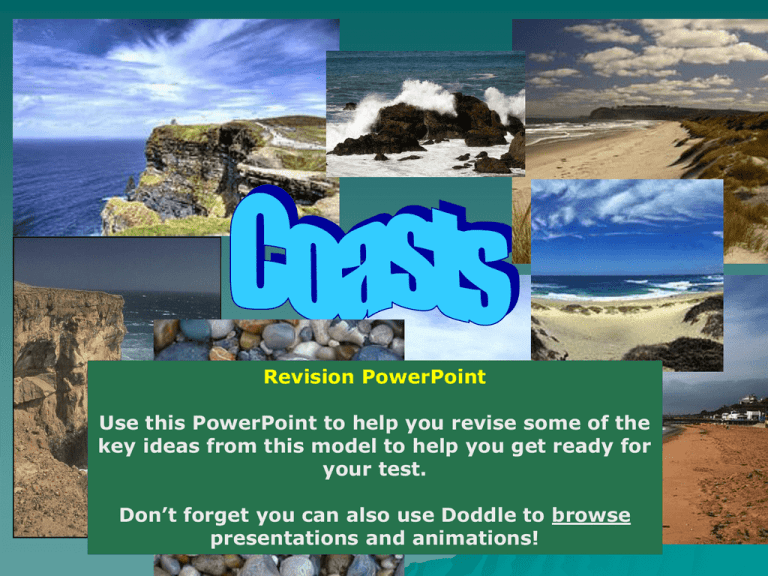
Revision PowerPoint Use this PowerPoint to help you revise some of the key ideas from this model to help you get ready for your test. Don’t forget you can also use Doddle to browse presentations and animations! What is the Coast? What do we use it for? The Coast is where the land meets the sea. The next slide some of the many things we use the coast for. Many people visit the coast for leisure and holidays. People live and work there. Could any of these activities conflict? Could any of these conflict? The Power of the waves Waves are changing the coast every day, they do this by following a master plan Erode Waves at Work Transport Deposit Waves change the coast in 3 ways Erode Transport Deposit What do these keywords mean? Waves erode (wear down) the coast. Waves transport (move) the eroded material. Waves deposit (drop) this material in sheltered areas where they lose their energy. There are 4 types of Erosion By Waves Waves smash against the rock, breaking the rock up over time. Hydraulic action solution erosion attrition Abrasion How do these types of erosion work? Hydraulic Action Waves force water into cracks under pressure. This helps break up the rock. Solution Water dissolves soluble material from the rock. Abrasion Waves fling sand,pebbles and large stones against the rock. This acts as sand paper wearing away the rock. Attrition Waves knock together the pieces of rock broken off by erosion. These wear down into smaller and smaller pieces. The rock wears down into shingle (Pebbles) and sand. The waves don’t have all the power! Erosion of the cliffs also occur from weathering What are the different types of weathering ? Water trickles into cracks.In icy weather it freezes, forcing the cracks wider until the rock breaks up. In hot places, Like deserts, the rock heats up during the day and expands. At night it cools and contracts this weakens the rock. The outer layers of he rock break uprather like an onion skin. Plant and tree roots grow in cracks and widen them, causing the rock to break up Remember Science? Water reacts with Carbon dioxide in the air. The water becomes slightly acidic. (Carbonic acid). This dissolves the rock. Erosion of a Headland Caves Arches Stacks Stumps The video link below will help you reacp these land forms: http://www.bbc.co.uk/learningzone/clips/coastlines-cavesarches-and-stacks/8432.html Make sure you can describe and explain how these land forms are created. Remember your P2L, the big picture activity and your diagram? Geog 2 describes the process of a headland being eroded as shown below: Erosion of a Headland Crack Stack Arch Cave Stump Waves transport the material they erode from the land. Much of the material is transported by Longshore drift What happen when the waves reach the land? When the waves reach the beach, they break and cause a swash and backwash. When the water rushes up the beach with lots of energy this is called the swash When the water rushes down the beach with a lot less energy this is called the backwash Longshore Drift How the eroded rock moves around SEA Direction of longshore drift Many seaside towns build groynes to stop their beaches being washed away The groyne disrupts longshore drift How do groynes work? Direction of longshore drift Wave direction Pebbles and sand carried by longshore drift are stopped by the groyne, so the beach builds up on this side On this side longshore drift carries on . It moves pebbles and sand away in the direction of the longshore drift, so there is less beach material. . Watch this video clip to see longshore drift in action. http://www.bbc.co.uk/learningzone/clips/thecoastline-longshore-drift-and-spits/3086.html Cliff Collapse Wave erosion, Weathering and rain combine to weaken cliffs. This can cause them to collapse. Holbeck Hall Hotel in Scarborough Weathering Chemical: rain soaks in and dissolves minerals Freeze- thaw: In winter water freezes in the cracks making them larger If we can reduce the effects of these processes, we can prevent cliffs falling into the sea. Cliff Collapse Make sure you can describe, explain and evaluate the advantages and disadvantages of the different methods we use to prevent cliff collapse. Rain Wave Erosion Soaks into the cracks. It makes clay cliffs very slippery. The clay can just slide away. Waves attack the cliff through Hydraulic Action, Abrasion, Solution and Attrition. Rock Armour Heavy rocks cemented in front of the cliff. Absorbs energy from the waves. Creates a barrier protecting the land from attcak by wave erosion. Difficult to transport heavy stones Interferes with Longshore Drift Ugly, spoils the view and some of the beach is covered. Heavy lorries need to transport the rocks causing traffic problems, noise and pollution. Needs to be replaced when it has been eroded. Drainage Pipes Pipes that are dug into the cliff. Drains away water from the cliff, so it is less slippery. It doesn’t spoil the view. Very Effective, especially to protect soft clay cliffs that become very slippery when they are saturated with water. Very expensive to install. Noise, pollution and disruption while trenches are dug to install the pipes. Salt resistant vegetation Plants that can survive in salty conditions near the coast are planted on the cliff. They draw out some of the water from the cliff. Their roots bind the soil together, stabilising it and making it less likely to slip. Quite cheap and low maintenance. Looks natural and could create habitats. Loss of agricultural (Farm) land. Changes the natural habitat of animals and plants Wave Barriers/Granite Reefs Break the waves away from the coast Doesn’t stop Longshore Drift completely Extremely expensive Groynes Stops Longshore drift causing sand to build up. Ugly and costly to maintain Beach Replenishment Replacing the material moved by waves. Natural effect against erosion Needs constant “Topping up” (replenishment) There is always a downside… Knock on Effects If we stop erosion and cliff collapses in one place, longshore drift will not be able to transport the eroded material along the coast to another place. The beach there will not be replenished, but it will be transported away by longshore drift. This means erosion will be worse there as there is less beach to protect the coast However we protect the coast or try to prevent cliffs collapsing there will be a disadvantage.
